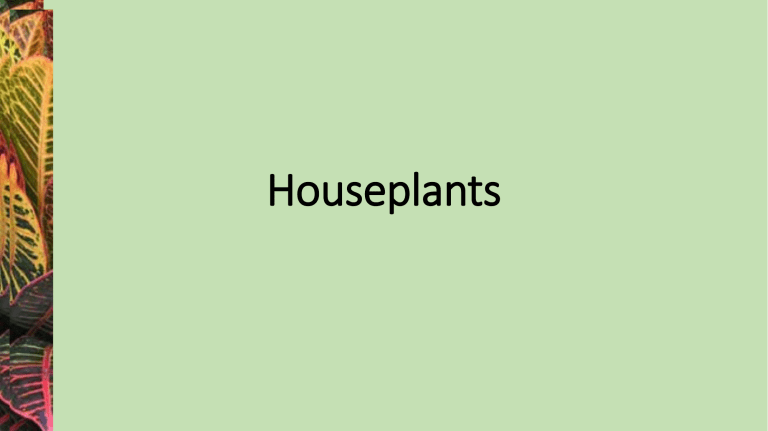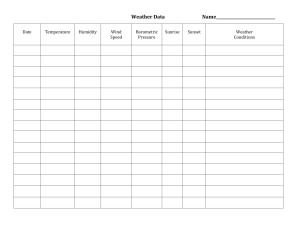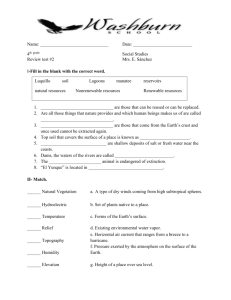
Houseplants Why do you want a house plant? • Adds color to your décor • Purifies the air • Adds interest to a corner, dark space or sunny location • Adds texture to a room • Extends your gardening experience • You like living things in your home • You just don’t know but can’t not have them • Someone dear gave you one and now you need to keep it alive Major factors to consider for growing house plants • Light • Temperature • Moisture • Humidity • Soil • Containers • Fertilizers • Pest control Light Categories • Low: light shade, a northern exposure, few plants thrive • Medium: average indoor light, plants are several feet from an east or west facing window, no direct sun except north facing, many foliage plants adapt, but few will bloom • Bright : directly in front of an east or west facing window, several feet back from a south facing window, African violets and many orchids are in this category • Direct: more than 4-5 hours of direct sunlight daily; unshaded south window in summer; cacti and succulents Temperature • Most houseplants are tropical species • Many popular houseplants are adapted to thrive in a climate from 60 °F to 80 °F similar to the temperature in most homes • If you’re comfortable, your houseplant probably is • Daytime temperatures should be higher than nighttime temperatures • Steer clear of drafts and blowing air, cold or hot • Most houseplants don’t do well below 55 °F Moisture • Under-watering or over-watering is detrimental to most houseplants • Check soil moisture - most plants must reach an appropriate level of dryness ranging from slightly moist on the surface to very dry • Weekly watering –maybe??? • Most plant do best with complete saturation • Start a weekly routine: pick a water day • Watering will change with the season • Experience will guide in the “how much” department Humidity • Humidity is more difficult to control than temperature • Many houseplants can survive low humidity environments as long as roots are kept properly irrigated • Many plants thrive in 80% relative humidity • Most homes usually around 20% to 60% relative humidity • Besides humidifier, use pebble trays • Grouping plants closely together Soil • 3 main purposes: anchorage, store water and nutrients, and provide air circulation • Use the right soil for the plant • Cactus need fast drainage, African violets like a light mix • Use potting soil, not native soil for most house plants • Potting soils usually contain a combination of peat (or coir) and vermiculite or perlite • For plants requiring plenty of moisture, use 2 parts peat (or coir) and 1 part perlite Containers • Get yourself a pot with drainage holes on the bottom and a saucer to catch water, but discard excess water • New pot should be no more than 1-2” larger in diameter • Clay pots allows excess moisture to evaporate • Plastic holds moisture longer Fertilizer • Fertilize plants only when they are actively growing • If plant has been in the same pot for a year use a complete fertilizer at half the recommended label rate • Chose a balanced fertilizer – 5-10-50 or 10-10-10 • Nitrogen for green, leafy growth • Phosphorus for flowering or fruiting plants • Potassium is essential for strong roots • A complete fertilizer includes minor and trace elements, i.e. calcium, magnesium and iron • In most cases, it is better to under-fertilize than over-fertilize • Schedules can range from every other week to every three months • If you fertilize more frequently, the plants may outgrow their pots and space • Plants may be damaged with too much fertilizer, especially when their growth rate is slowed in dim light, too much fertilizer can burn roots. • Avoid salt build up, periodically completely saturate pot and allow to drain Pothos, Devil’s Ivy Epipremnum aureum Araceae •Match the plant’s needs to the environment you have currently •Match plant needs to your time to care for the plant •Keep in mind safety considerations for pets and children Pothos, Devil’s Ivy Epipremnum aureum Araceae •From Solomon Islands, French Polynesia •Low to medium light •Poisonous •Stem cuttings •Undemanding •Few problems •Keep on the dry side Peace Lily Spathiphyllum wallisii Araceae •From Central America, Indonesia, and the Philippines •Low to medium light— good for office settings •Shiny foliage •Best for air cleaning •Propagate by division •Prefers high humidity for best flower production Philodendron Philodendron scandens oxycardium Araceae •From Mexico •Low light to medium light •Understory plant, uses adventitious roots to anchor itself to trees •Poisonous–calcium oxalate crystals •Propagate via stem cuttings Sansevieria, Mother‐in‐law’s Tongue Sansevieria trifasciata Agavaceae •From Indonesia, India, tropical Africa •Tolerate many light levels •Do not overwater •Easy to propagate •Few problems •Top heavy •Undemanding Dracaena, Madagascar Dragon Tree Dracaena marginata Agavaceae •From Mexico, Columbia, Brazil, Puerto Rico •Calcium oxalate in all plant •Medium to high light •Low humidity ok but don’t let get too dry •Too much fertilizer causes marginal leaf burn •Propagate by air layering or cane cuttings •Few problems African Violet Saintpaulia ionantha Gesneriaceae •The African violet was first discovered in East Africa in 1892 by Baron Walter von St. Paul •Best under grow lights or east, or open north side window •Likes highly organic soil •Propagate by leaf cuttings in spring •Mealy bugs, powdery mildew, cyclamen mite and stem or crown rot can be problems Aloe Aloe vera Asphodelaceae (was Liliaceae) •From Africa •Native environment is maritime sands and rocks •Medium to high light levels needed •Average home humidity is OK •Propagates by offsets •Few problems •Do NOT over‐water or over‐fertilize Weeping Fig Ficus benjamina Moraceae •From India, Southeast Asia, northern tropical Australia •Latex‐like sap is exuded when pruned •Bright to medium light, but not south •Likes high humidity •Does not like drafts •Do not overwater •Scale, mealybugs, spider mites can be issues Fiddleleaf Fig Ficus lycata Moraceae •From western Africa where it grows in lowland tropical rainforest •Bright to medium light, not southern exposures •Likes high humidity •Does not like drafts •Do not overwater or underwater •Scale, mealybugs, spider mites can be problems Fiddleleaf Fig Ficus lycata Peperomia Peperomia spp. Piperaceae •From Central America, northern South America, a few from Africa •Low to medium light— are understory rainforest plants •Attractive and varied foliage types •Many are epiphytes •Medium humidity •Don’t overwater •Cuttings don’t root easily—use rooting hormone Aluminum Plant Pilea cadieri Urticaceae •From Vietnam •Perennial where native •Medium to bright indirect light – loses variegation if light level is too low •Best in high humidity – use pebble tray •Good in tall terrariums •Soil should not be too wet – rots easily •Perennial where native •Pinch to keep bushy and propagate via cuttings Chinese Money Plant, Pass It On Plant, UFO Plant Pilea peperomioides Urticaceae •From China •Moist soil •Best in high humidity •Bright indirect light •Rotate plant 2-3 times a week •Propagate by selecting ‘babies’ Baby’s Tears Soleirolia soleirolii Urticaceae •Islands in the Western Mediterranean such as Corsica and Sardinia •Often used in fairy gardens and terrariums •Moist soil •Best in high humidity •Bright indirect light •Perennial where native •Propagate via cuttings or division



